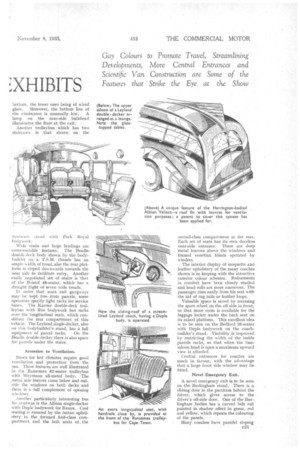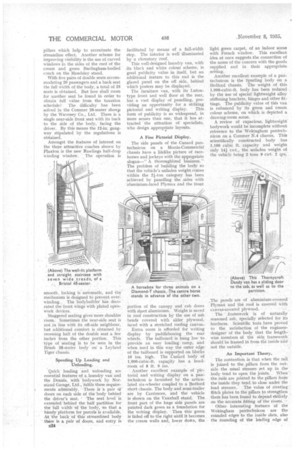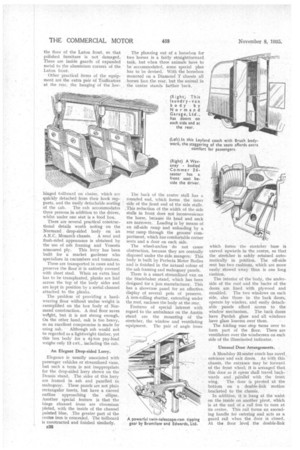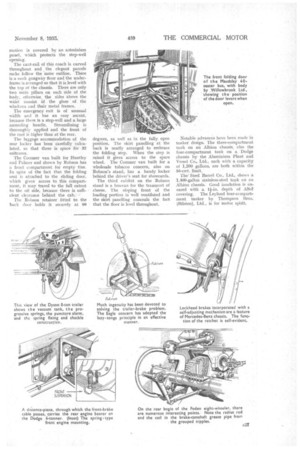Our Experts Survey THE BODY WOR iXHIBITS
Page 144

Page 145

Page 146

Page 148

Page 149

If you've noticed an error in this article please click here to report it so we can fix it.
OLYMPIA is gay with . colour schemes, owing to the increased amount of attention paid to decoration to enhance streamlined effects. There is Much variety in the schemes adopted for exterior display. Usually, the coloured belts and panel -areas are outlined with an attractive alloy moulding. The back of the coach is treated in a similar manner.
Moreover, there are More coaches shown this year, than at the previous Exhibition, with full-Width .6,1.bs; so that there has been a definite advance in streamlining. The revival of interest in the full-width cab is, no doubt, stimulated by the increasing number of trolleybuses in service which, like those exhibited at Olympia, whether single:. or double-deckers, have full -width fronts. This Streamlining is no formal acquiekerice in a: modern tendency, because some of the cabs curve under also at the bottom.
Streamlining the Vogue.
More streamlining and appropriate moulding displays and colour arrangements, are also to be seen on some of the petrol and oil-engined double
deckers. There .is, for instance, the A.E.C. 56-seater with 'Roe bodywork for Leeds Corporation, which has a fullwidth cab. The aerodynamic. effect is emphasized-by the single,-boldly curved metal moulding at the waist of both
saloons. • Another attractively designed doubledecker is that for Sheffield Corporation, shown by Park Royal CoaChworks, Ltd. Not only is there a pronounced slope both to the front and back of the upper saloon, but there is a shaped near-side , front pillar similar to that adopted for coaches, The Albion double-decker with Duple bodywork, shown by the bodybuilder, has an upper and lower belt panel with alloy mouldings and a vee-shaped centrepiece. These belts, being in red, make.an effective contrast with the grey panelling. • Apart from these attractive exterior effects, there are sev.eral interesting features in seating and equipment. On E.22 the Leyland stand the double-decker with all-metal bodywork has seats with tubular frames in the latest style for service use, but in the upper saloon
there is a surprise. Along each side single and double armchairs for 11 persons are arranged at inviting angles, with high and low glass-topped tables on tubular legs. The pattern of the moquette of the seats has been skilfully reproduced with semi-plastic paint and stencilling to decorate the sides of the saloon. This special lounge is not standard equipment, but it gives an idea of what may be achieved for private hire or excursions if the usual seats be easily removable.
There is a double welcome to the central entrance of the English Electric 48-seater on a Leyland chassis. Over the entrance, with its pneumatically operated doors sliding in opposite directions, is the sign " Welcome Inn Blackpool," whilst the inlaid rubber flooring needs no wording, because its tasteful colour scheme is sufficient to repeat the invitation. -.There is a usedticket box on each side of the entrance.
. Careful Staircase Design.
Careful planning is evident with the staircase of the double-decker on the Duple stand. This leads to an Off-side stink gangway; where one may' step ' straight ahead or ascend another tread to the back seat. In the upper saloon the seats are alternately for three or four passengers, thus providing recesses to facilitate reaching and leaving seats.
Visibility and safety have been specially studied on the LeylandG.E.C. trolleybus. This has an entrance staircase at the rear and an exit staircase in front. The driver has an excellent view ahead and to the neat side. The front doors, which are controlled by Dorvac air-operated gear, have glazed panels both at the top and bottom, the lower ones being of wired glass. Moreover, the bottom line of the windscreen is unusually low. A lamp on the near-side bulkhead illuminates the floor at the exit.
Another trolleybus which has two staircases is that shown on the Sunbeam tand with Park Royal bodywork.
Wide stairs and large landings are commendable features. The Beadle double-deck body shown by the bodybuilder on a T.S.M. chassis has an ample width of tread, also the rear platform is sloped downwards towards the near side to facilitate entry. Another easily negotiated set of stairs is that of the Bristol 48-seater, which has a straight flight of seven wide treads.
In order that seats and gangways may be kept free from parcels, some operators specify light racks for service buses. The Karrier double-deck trolleybus with Roe bodywork has racks over the longitudinal seats, which constitute the rear compartment of this vehicle. The Leyland single-decker, also on this bodybuilder's stand, bas a full equipment of parcel racks. On the Beadle double-decker there is also space for parcels under the stairs.
Attention to Ventilation.
Buses for hot climates require good ventilation and protection from the sun. These features are well illustrated in the Ransomes 62-seater trolleybus with Weymann all-metal body. The metal side louvres come below and out side the windows on both decks and there is a full complement of opening w %lows.
Another particularly interesting bus for overseas is the Albion single-decker with Duple bodywork for Kenya. Cool seating is ensured :by the rattan upholstery. , in the forward first-class compartment and the lath seats °C .-the
second-class compartment at the rear. Bach set of seats has its own doorless near-side entrance. There are deep metal louvres above the windows and framed venetian blinds operated by winders.
The interior display of moquette and leather upholstery of the many coaches shown is in keeping with the attractive exterior colour schemes, Refinements in comfort have been closely studied and head rolls are more numerous. The passenger rises easily from his seat with the aid of rug rails or leather loops.
Valuable space is saved by recessing the spare wheel on the off side in front, so that more room is available for the luggage locker under the back seat on its raised platform.. This excellent idea is to be seen on the Bedford 25-seater with Duple bodywork on the coachbuilder's stand. Visibility is improved by restricting the width of the inside parcels racks, so that when the Sunsaloon head is open a maximum upward view is afforded.
Central entrances for coaches are much in favour, with the advantage that a large front side window may be fitted.
Novel Emergency Exit.
A novel emergency exit is to be seen on the Burlingham stand. There is a sliding door in the partition behind the driver, which gives access to the driver's off-side door. One of the Burlingham bodies has a curved belt rail painted in shadow effect in green, red and yellow, which repeats the colouring of the panels.
Many coaches have parallel sloping E23 pillars which help to accentuate the streamline effect. Another scheme for improving visibility is the use of curved windows in the sides of the roof of the cream and green Burlingham-bodied coach on the Maudslay stand.
With five pairs of double seats accommodating 20 passengers and a back seat the full width of the body, a total of 25 seats is obtained. But bow shall room for another seat be found in order to obtain full value from the taxation schedule? The difficulty has been .solved in the Commer 26-seater showp by the Waveney Co., Ltd. There is a single near-side front seat with its back to the side of the body, facing the driver. By this means the 12-in: gangway stipulated by the regulations is obtained.
, Amongst the features of interest on the three attractive coaches shown by Plaxton is the new Rawlings half-drop Winding window. The operation is . . smooth, locking is automatic, and the • mechanism is designed to prevent overwinding.. The bodybuilder has decorated the front wings With plated open Work devices. • . • • • • Staggered seating gives more shoulder room. Sometimes the near-side seat is not in line with its off-side neighbour, but additional comfort is obtained by recessing half of the double seat a few inches from the other Portion. This type of seating is to be seen. in the Brush 28-seater body on a Leyland Tiger chassis. •• Speeding Up Loading and Unloading.
Quick loading and unloading are essential features :of a laundry van and the Dennis, with • body work by NorMaud Garage; Ltd.; fulfils these requirements admirably. -There is a pair of doors on each side of the "body behind the driver's seat. ' •The seatlevel is extended behind the half partition for the full widthof the body, So. that a handy-platform for parcels is available, At the back of this stfeamlined body there is a pair of doers, and entry is •
E24 • facilitated by means of a full-width step. The interior is well illuminated by a clerestory roof. This well-designed laundry van, with its black and white colour scheme, is good publicity value in itself, but an additional feature to this end is the glazed panel on the off side, behind which posters may be displayed.
The furniture van, with its Lutontype front and well floor at the rear, has a vast display of panelling, providing an opportunity for a striking pictorial and writing display. • This form of publicity is so widespread, in more senses than one, that it has attracted • the attention of specialists; who design appropriate layouts.
A Fine Pictorial Display.
The side panels of the Cunard pantechnicon on a Morris-Commercial chassis have a lifelike picture of racehorses and jockeys with the a.ppropriate slogan—" A thoroughbred business." The problem of building the body so that the vehicle's unladen weight comes within the 2k-ton category has been achieved by panelling the sides with aluminium-faced Plymax and the front portion of the canopy and cab doors with sbeet aluminium. Weight is saved in roof construction by the use of ash bends covered with alder plywood, faced with a stretched roofing canvas.•
Extra room is afforded for writing display by paddleboxing the rear wheels. The tailboard is hung low to provide an easy lOading ramp, and when used in this way the outer edge of the tailboard is supported on blocks 10 ins. high. The Cunard body of 1,000-cubic-ft. capaeity has a headroom of 8 ft. 9 ins.
Another excellent example of pictorial and writing display on a pantechnicon is furnished by the articu, lated six-wheeler coupled to a Bedford short chassis. The body and semi-trailer are by Carrimore, and the vehicle is shown on the Vauxhall stand. The front part of the huge side panels are painted dark green as a foundation for the 'writing display; Then this green is faded Off to the right until it becomes the cream walls and, lower doVen, the light green carpet, of an indoor scene with French window. This excellent idea at once suggests the connection of the name of the concern with the goods supplied and in their appropriate setting.
Another excellent example of a pantechnicon is the Spurling body on a Bedford chassis. The weight of this 1,000-cubic-ft. body has been reduced by the use of special lightweight alloy stiffening brackets, hinges and other fittings. The publicity value of this van is enhanced by its green and cream colour scheme, on which is depicted a drawing-room scene.
A review of capacious, lightweight bodywork would be incomplete without reference to the Wokingham pantechnicon on a Commer N.4 chassis. This scientifically constructed body has 1,100 cubic ft. capacity , and weighs only 141 cwt,, the unladen weigbt of the vehicle being 2 tons 9 cwt. 2 qrs.
The panels are of aluminium-covered Plymax and the roof is covered with canvas-Covered plywood.
The framework is of naturally seasoned ash, specially selected for its hardness. Scientific tests have proved' to the satisfaction of the engineerdesigner of the body that the lengthwise members of the side framework: should be framed in from the inside and not the outside. '
An Important Theory.
The contention is that when the rail is joined to the pillars from the outside the usual stresses set up in the body tend to open the joints. When the rails are jointed to the pillars froin the inside they tend to close under the load stresses. The valtie of riveting • flitch plates to the pillars to strengthen them has been found to depend entirely On the accurate fitting Of the' rivets.
Other interesting features of the Wokingham pantechnicon are thefl rounded edges to the inside slats, also the rounding of the leading edge of the floor of the Luton front, so that polished furniture is not damaged. There are inside guards of expanded metal to the aluminium corners of the Luton front.
Other practical items of the equipment are the extra pair of Trafficators at the rear, the hanging of the low hinged tailboard on chains, which are quickly detached from their hook supports, and the easily detachable seating of the cab. The cab, accommodates three persons in addition to the driver, whilst 'under one seat is a food box.
There. are several practical constructional details worth noting on the Normand drop-sided body on an A.E.C. Monarch chassis. A neat and flush-sided appearance is obtained by the use of ash framing and Venesta armoured ply. This lorry has been built for a market gardener who specializes in cucumbers and tomatoes.
These are transported in cases and to preserve the floor it is entirely covered with sheet steel. When an extra load has to be transplanted, planks are laid across the top of the body sides and are kept in position by a metal channel attached to the planks.
The problem of providing a hardwearing floor without undue weight is exemplified on the box body of Normand construction. A deal floor saves weIght, but it is not strong enough. On the other hand, oak is too heavy, so an excellent compromise is made by using ash. Although ash would not he regarded as a lightweight timber, yet this box body' for a 4/-ton pay-load weighs only 13 cNat., including the cab.
An Elegant Drop-sided Lorry.
Elegance is usually associated with passenger vehicles or streamlined vans, but such a term is not inappropriate for the drop-sided lorry shown on the Dennis stand. The sides of this lorry are framed in ash and panelled in mahogany. These panels are not plain rectangular insets, but have a curved outline approaching the ellipse. Another special feature is that the hinge channel irons are chromium plated, with the inside of the channel painted blue. . The greater part of the centre iron is concealed. The tailboard is constructed and finished similarly.
E26 The planning out of a horsebox for two horses is a fairly straightforward task, but when three animals have to be accommodated, some special plan has to be devised. With the horsebox mounted on a Diamond T chassis all horses face the rear, but the animal in the centre stands farther back.
The back of the centre stall has a rounded end, which forms the inner side of the ,front end of the side stalls. This reduction of the width of the side stalls in front does not inconvenience the horse, because its head and neck are narrower. Loading is by means of an off-side ramp and unloading by a rear ramp through the grooms' compartment, which has comfortable corner seats and a door on each side.
The wheel-arches do not cause obstruction, because they are centrally disposed under the side mangers. This body is built by Perfecta Motor Bodies and is finished in the natural colour of the ash framing and mahogany panels.
There is a smart streamlined van on the Studebaker stand, which has been designed for a jam manufacturer. This has a showcase panel for an effective. display of several pots of preserve. A non-rolling shutter, extending under the roof, encloses the body at the rear. Features of special interest with regard to the ambulance on the Austin stand are the mounting of the stretcher, the window and ventilating equipment. The pair of angle irons
which forms the stretcher base is curved upwards in the centre, so that the stretcher is safely retained automatically in position. The off-side seat has two cushions, which are more easily stowed away than is one long cushion.
The interior of the body, the underside of the roof and the backs of the doors are lined with plywood and moulded. The two windows on each side, also those in the back doors, operate by winders, and easily detachable panels afford access to the window mechanism. The back doors have Purdah glass and all windows have glass louvres over them.
The folding rear step turns over to form part of the floor. There are ventilators over the windscreen on each side of the illuminated indicator. • Unusual Door Arrangements. • A Maudslay 32-seater coach has novel , entrance arid exit doors. As With this chassis, the entrance may be forward. ofthe front wheel; it is arranged that this door as it opens shall travel backwards and parallel with the front wing. The door is pivoted at the bottom on a double-link motion bracketed to the chassis. •
In addition, it is hung at the waist on the inside on another pivot, which is at the end of a rail free to turn at its centre. This rail forms an ascending handle for entering and acts as a guard rail when the door is closed. At the floor level the double-link
motion is covered by an anlininium panel, which protects the step-well opening.
The cant-rail of this coach is curved throughout and the elegant parcels racks follow the Same outline. There is a sunk gangway floor and the underframe is arranged so that it is level with the top of the chassis. There are only two main pillars on each side of the body, otherwise the sides above the waist consist Of the glass of the windows and their metal frames.
The emergency exit is of unusual width and it has an easy ascent, because there. Is a step-well and a large ascending handle. Streamlining is thoroughly applied and the front of the roof is higher than at the rear.
The luggage accommodation of the rear locker has been carefully calculated, so that there is space for 32 suitcases.
The Commer van built for Huntley and Palmer and shown by Robson has a front compartment for empty tins. In spite of the fact that the folding seat is attached to the sliding door, which gives access to this Compartment, it may travel to the full extent to the off side, because there is sufficient clearance behind the cab: • The Robson retainer fitted to the back door holds it securely at 90 degrees, as well as in the fully open position. The skirt panelling at the back is neatly arranged to embrace the folding step. When the step is raised it gives access to the spare wheel. The Commer van built for a wholesale tobacco concern, also on Robson's stand, has a handy locker behind the driver's seat for showcards.
The third exhibit on the Robson stand is a boxvan for the transport of cheese. The sloping front of the loading portion is well ventilated and the skirt panelling conceals the fact that the floor is level throughout. Notable advances have been made in tanker design. The three-compartment tank on an Albion chassis, also the four-compartment tank on a Dodge chassis by the Aluminium Plant and Vessel Co., Ltd., each with a capaCity of 1,200 gallons, are both Within the 50-cwt. limit.
The' Steel Barret Co., Ltd., shows a 1.44)0-gallon stainless-steel tank On an Albion chassis. Good insulation is en sured with a depth of Alfok covering. The Leyland four-compartment tanker by Thompson Bros. (Bilston), Ltd., is for motor spirit.












































































































































































































































































































